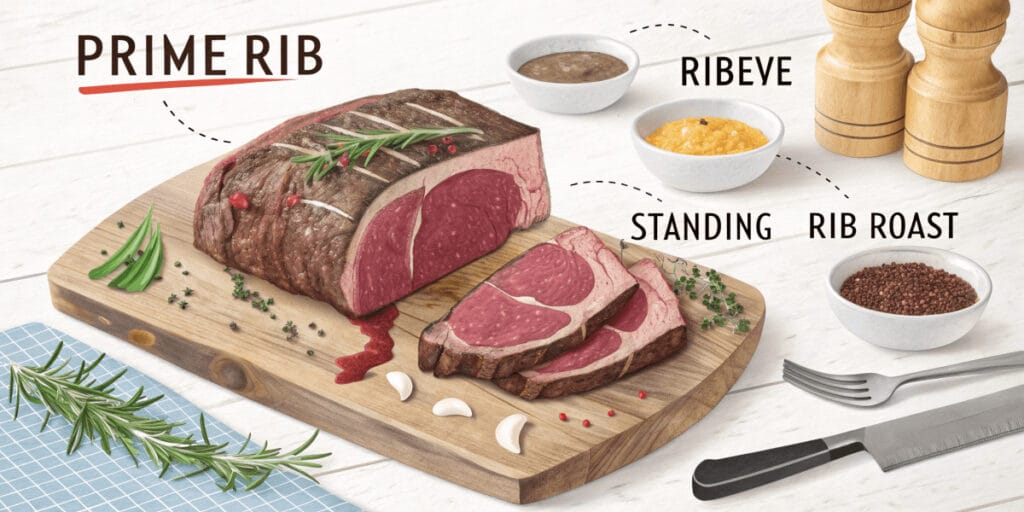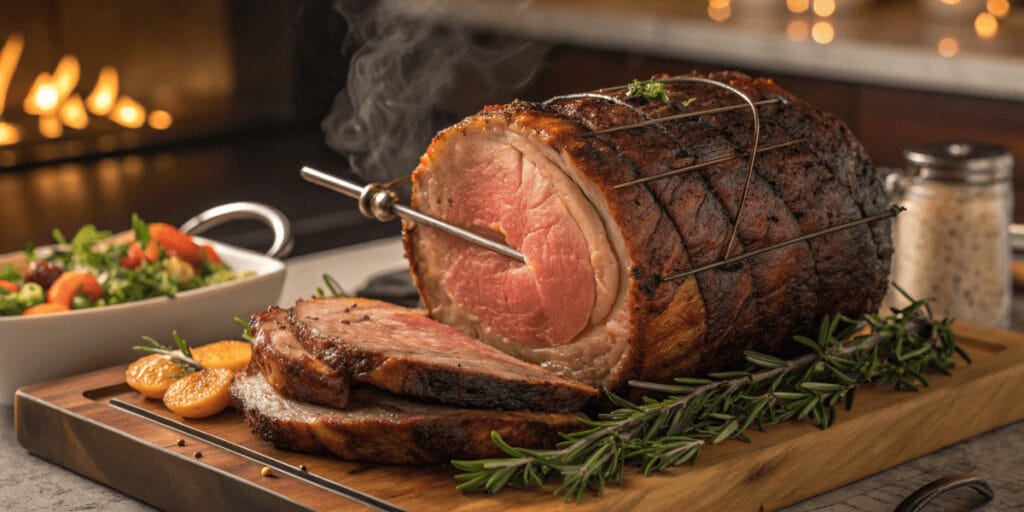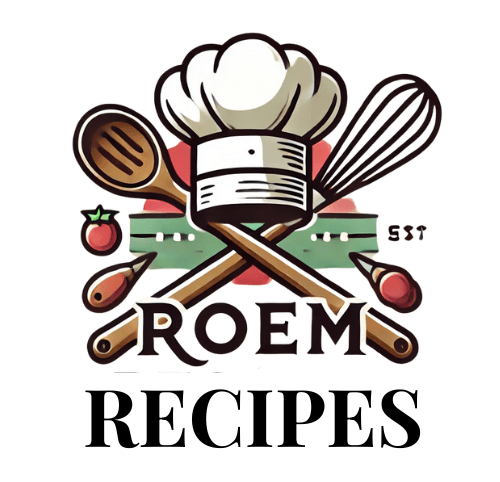Imagine a family gathering with a rotisserie prime rib roast as the main attraction. It’s golden brown, richly marbled, and promises tender, juicy meat. This meat practically melts in your mouth.
Cooking a prime rib roast might seem tough, but with the right methods, it’s achievable. Whether it’s for a holiday or a weekend dinner, mastering rotisserie prime rib boosts your cooking. It impresses your guests too.
This guide covers all you need to know about making the tastiest juicy prime rib. You’ll learn how to pick the best cut and achieve tender, flavorful results. These professional techniques turn a simple meal into a memorable feast.
The key to a great rotisserie prime rib is knowing the meat, choosing quality beef, and cooking it right. We’ll show you how to select, prepare, and cook your prime rib perfectly. This ensures a memorable meal that everyone will want more of.
Understanding Prime Rib: Cuts and Quality Selection
Choosing the right prime rib is all about knowing the grades, cuts, and serving sizes. Your goal is to make a roast that wows everyone.

Prime Rib Grades Explained
Understanding the USDA grading scale is key when picking prime rib. The top two grades are Choice and Prime. Prime is the highest, with lots of marbling for a rich taste.
- Prime Grade: Highest quality with superior marbling
- Choice Grade: Good quality with moderate marbling
- Select Grade: Leaner with less intramuscular fat
Bone-in vs Boneless Prime Rib
The type of prime rib you choose affects taste and look. Bone-in prime ribs are often more flavorful, with 5-7 bones. Boneless roasts are easier to carve but might taste less natural.
| Cut Type | Flavor Profile | Weight Loss |
|---|---|---|
| Bone-in Prime Rib | More intense flavor | Approximately 30% weight loss |
| Boneless Prime Rib | Milder flavor | Approximately 20% weight loss |
Prime Rib Serving Size Guidelines
When planning your prime rib serving size, aim to please everyone. For bone-in prime rib, plan for about 1/2 pound per person. For boneless, it’s 3/4 pound per person.
“Eight ounces of cooked prime rib per person provides a generous and satisfying meal.”
If you have big eaters or want leftovers, add more to your serving size. Always check the meat with a thermometer. For medium-rare, it should be 125°F.
Essential Equipment for Rotisserie Prime Rib Success
To make a perfect prime rib on a rotisserie, you need the right tools. These tools turn a simple roast into a special meal. Having the right gear is key to success.

- Rotisserie-capable grill or standalone rotisserie unit
- Digital meat thermometer with probe
- Stainless steel meat forks
- Butcher’s twine for securing the roast
- Sharp carving knife
- Heavy-duty basting brush
Your digital meat thermometer is very important. Precision is key when cooking prime rib. Just a few degrees can change the meat from rare to medium-rare.
“The right tools make all the difference between a good and a great prime rib.” – Professional Chef
When picking rotisserie equipment, think about your roast’s size and your grill’s power. A strong rotisserie motor should handle roasts up to 20 pounds. Look for units with adjustable spit rods and secure mounting for even cooking.
Pro tip: Choose quality prime rib cooking tools that last. Stainless steel tools resist rust and are durable for many uses.
Preparing Your Prime Rib for the Rotisserie
Getting your prime rib ready for the rotisserie is a detailed process. The right steps can turn a great cut of meat into a memorable meal. Prime rib preparation includes key steps for flavor and tenderness.
Trimming and Tying Techniques
Start by trimming off excess fat, but keep a thin layer. This fat keeps the meat moist. Use sharp shears to even out the edges for even cooking.
- Leave approximately 1/4 inch of fat cap
- Remove silver skin and tough membranes
- Use butcher’s twine to secure the roast’s shape
Seasoning Methods and Rubs
Seasoning prime rib is an art that can make your roast stand out. A mix of kosher salt, black pepper, and garlic powder is a classic choice. For more flavor, try adding herbs like rosemary and thyme.
“The secret to an amazing prime rib is in its seasoning.” – Professional Chef
Marinating and Dry Brining Tips
Dry brining prime rib is a technique that boosts flavor and moisture. Salt the roast well 24-48 hours before cooking. Let it rest uncovered in the fridge. This method creates a tasty crust and juicy meat.
- Apply kosher salt liberally
- Refrigerate uncovered overnight
- Pat dry before cooking
Make sure to let your prime rib come to room temperature before cooking. It usually takes about 4 hours. This helps with even cooking and reaching your desired doneness.
Rotisserie Prime Rib Roast Temperature Guide
Mastering the prime rib cooking temperature is key to a perfect roast. Your meat thermometer is your best friend in this process. It helps you hit the right internal temperature for a delicious meal.
Each level of doneness has its own temperature range. Here’s a guide to help you achieve the perfect roast:
| Doneness Level | Internal Temperature | Recommended Removal Temperature |
|---|---|---|
| Rare | 120-125°F | 115°F |
| Medium-Rare | 130-135°F | 125°F |
| Medium | 140-145°F | 135°F |
| Medium-Well | 150-155°F | 145°F |
| Well-Done | 160°F and above | 155°F |
Pro tip: Remove the roast 5-10°F before your final temperature. It will continue cooking as it rests. This helps the juices spread evenly for perfect doneness.
“Temperature control is the secret to a perfectly cooked prime rib roast.” – Professional Chef
- Use a reliable meat thermometer
- Check temperature in the thickest part of the roast
- Avoid touching bone when measuring temperature
Remember, patience is key when monitoring your prime rib doneness. A few degrees can make the difference between a good and an exceptional roast.
Step-by-Step Rotisserie Cooking Process
Mastering the rotisserie prime rib process needs precision and attention to detail. Your journey to a delicious roast starts with knowing the key steps. These steps turn a simple cut of meat into a culinary masterpiece.
Setting Up Your Grill
Get your grill ready for an amazing rotisserie prime rib experience. Follow these important steps:
- Preheat the grill to medium-high heat (400°F)
- Make sure the rotisserie attachment is secure
- Put the spit through the center of the roast
- Balance the meat evenly to cook it right
Monitoring Internal Temperature
Tracking the temperature is key for the perfect doneness. Use a reliable meat thermometer to check the internal temperature.
| Doneness Level | Internal Temperature | Cooking Time |
|---|---|---|
| Rare | 120°F | 1-1/2 hours |
| Medium-Rare | 140°F | 1-3/4 hours |
| Medium | 150°F | 2 hours |
Basting Prime Rib Techniques
Boost your roast’s flavor and moisture with basting. The basting method involves coating the meat with its juices or beef tallow.
“Basting is the secret to a succulent, flavor-packed prime rib that will impress even the most discerning meat lovers.” – Culinary Expert
Here are some basting techniques to try:
- Baste every 20-30 minutes
- Use a long-handled basting brush
- Apply herb-infused oils or meat drippings
- Avoid opening the grill too frequently
Pro tip: Let the prime rib rest for 15 minutes after cooking. This lets the juices redistribute, making it tender and flavorful.
Optimal Cooking Times and Temperature Settings
Mastering the prime rib cooking time and rotisserie prime rib temperature is key to a perfect roast. It’s all about understanding how different factors affect your cooking.
When you’re getting ready to cook your prime rib roast, keep these temperature guidelines in mind:
- Preheat your grill for 10 minutes before cooking
- Initial searing temperature: 450°F to 500°F
- Target internal temperature for medium-rare: 117°F to 118°F
- Target internal temperature for medium: 123°F
For a typical 5-pound bone-in prime rib roast, here’s what you can expect:
| Cooking Stage | Temperature | Time |
|---|---|---|
| Initial Searing | 450°F-500°F | 25-30 minutes |
| Rotisserie Cooking | 325°F | 15 minutes per pound |
| Resting Period | Room Temperature | 15-20 minutes |
Pro tip: Always use a reliable meat thermometer to check internal temperature rather than relying solely on cooking time.
“The magic of prime rib is in the precision of temperature control” – Culinary Expert
Remember, your roast will keep cooking while it rests. It might even get 10°F warmer. For a 5-pound roast, plan about 1 hour and 16 minutes of total cooking time to get it just right.
Resting and Carving Your Prime Rib
The final steps of preparing your resting prime rib are crucial to achieving a perfect meal. After hours of careful cooking, your prime rib deserves special attention during the resting and carving process.
Mastering the Resting Period
Your prime rib needs time to relax after cooking. A proper resting time allows the meat’s internal juices to redistribute. This ensures each slice remains incredibly tender and flavorful.
Experts recommend letting your roast rest for 15-20 minutes. Some chefs suggest up to 30 minutes for larger cuts.
- Place the roast on a cutting board
- Tent loosely with aluminum foil
- Keep the meat in a warm area
- Avoid cutting immediately to preserve juices
Expert Carving Techniques for Prime Rib
Carving prime rib requires precision and the right tools. Select a sharp, long carving knife to create perfect, even slices. Begin by identifying the grain of the meat and cutting against it to maximize tenderness.
“A well-carved prime rib is the hallmark of a true culinary master.” – Professional Chef
| Carving Step | Technique |
|---|---|
| Preparation | Use a sharp long knife |
| Positioning | Place roast on stable cutting surface |
| Cutting Direction | Slice against the meat grain |
| Slice Thickness | 1/2 to 3/4 inch recommended |
For bone-in prime rib, consider cutting between the bones for an impressive presentation. Remember that patience during resting and carving transforms a good roast into an extraordinary dining experience.
Serving Suggestions and Accompaniments
Make your rotisserie prime rib even better with the right sides. These sides can turn a great meal into an unforgettable one.
Your prime rib needs sides that match its bold taste. Here are some top picks to make your meal stand out:
- Roasted Root Vegetables
- Creamy Garlic Mashed Potatoes
- Crispy Brussels Sprouts
- Classic Steakhouse Creamed Spinach
Pair your prime rib with classic steakhouse dishes. A homemade horseradish sauce adds a zesty touch that cuts through the meat’s richness.
| Side Dish | Preparation Time | Flavor Profile |
|---|---|---|
| Roasted Rosemary Potatoes | 30 minutes | Herbal, Crispy |
| Sautéed Green Beans | 15 minutes | Fresh, Buttery |
| Butternut Squash Gratin | 45 minutes | Creamy, Sweet |
“The perfect side dish elevates a great cut of meat from good to unforgettable.” – Chef Michael Roberts
For a luxurious touch, serve roasted bone marrow with your prime rib. It adds a fancy element that will wow your guests. They’ll see your thoughtfulness in choosing the perfect sides.
Before diving into the conclusion, don’t miss these related guides to expand your knowledge and skills in preparing prime rib roasts. If you’re curious about exploring other cooking methods, check out Mastering the Art of Grilled Prime Rib Roast: A Flavorful Feast for expert tips on grilling techniques. For a deeper understanding of different cuts of meat, Prime Rib vs. Ribeye Roast provides a detailed comparison. If precision cooking piques your interest, our guide on Sous Vide Prime Rib Roast showcases how to achieve perfectly cooked meat with sous vide. These resources will help you elevate your culinary skills and serve an unforgettable prime rib roast.
Conclusion
Creating a perfect prime rib feast takes patience, skill, and knowledge. Your journey begins with choosing top-quality meat. It ends with a dish that will wow your guests. By following the cooking tips and temperature advice, you can turn a simple dinner into a memorable event.
The secret to success is in controlling the temperature and understanding rotisserie cooking. Cooking for 15-20 minutes per pound helps the meat get rich flavors and stay tender. Remember, letting the prime rib rest for 15-20 minutes is key. This step makes sure each slice is juicy and tasty.
Whether it’s for a holiday meal or a fancy dinner party, your rotisserie prime rib skills will impress. With practice and focus, you’ll get better and better. Enjoy the art of rotisserie cooking, try new seasonings, and make every meal special.
With time, you’ll become confident in making a perfect rotisserie prime rib feast. Your guests will be amazed and can’t wait for your next dish.

